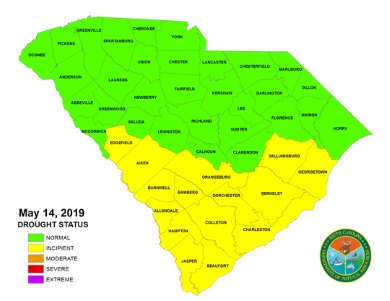May 14, 2019

Drought Response Committee declares "incipient" drought conditions in 15 counties
The S.C. Drought Response Committee, meeting via conference call on May 14, upgraded the drought status to Incipient Drought for 15 South Carolina counties. As designated by the South Carolina Drought Response Act, Incipient is the first level of drought followed by Moderate, Severe, and Extreme.
There was support from multiple indicators such as the 60-Day Percent of Normal Rainfall, the U.S. Drought Monitor, Palmer Drought Severity Index and the Crop Moisture Index to upgrade the 15 counties.
According to State Climatologist Hope Mizzell, rainfall over the last 60 days has ranged from 3.5 inches at Mount Pleasant, Charleston County, to over 17 inches at Sunset, Pickens County.
Most locations across the Upstate have received excessive rainfall throughout all of 2019. Slater-Marietta in Greenville County has already logged 39.52 inches of rain since Jan. 1, while some areas in the Lowcountry have received less than 10 inches.
The table below provides selected CoCoRaHS rainfall totals for the past 60-days and since Jan. 1.
| Station | March 15 – May 13 | January 1 – May 1 |
|---|---|---|
| Aiken 1.6 NNW | 7.14 | 14.46 |
| Allendale 1.7 SE | 4.35 | 9.68 |
| Columbia 7.4 N | 9.17 | 17.36 |
| Conway 6.2 E | 6.15 | 11.22 |
| Due West 0.6 SE | 6.38 | 18.92 |
| Florence 5.1 W | 7.58 | 15.06 |
| Greenwood 4.1 WSW | 4.43 | 14.9 |
| Hampton 0.3 WSW | 3.27 | 8.11 |
| Mt. Pleasant 1.0 WSW | 3.53 | 7.04 |
| Kingstree 7.9 NW | 6.23 | 13.56 |
| Lancaster 2.0 NNW | 10.34 | 21.77 |
| Lodge 3.4 SW | 5.33 | 11.9 |
| Orangeburg 3.2 NW | 6.73 | 13.33 |
| Pageland 9.0 WNW | 10.34 | 22.1 |
| Slater-Marietta | 16.9 | 39.52 |
| Sumter 0.2 NE | 7.04 | 15.7 |
| Sunset 2.9 W | 17.13 | 38.42 |
| Wellford 2.8 ENE | 7.88 | 22.58 |
Below normal rainfall levels over the past 60 days has resulted in below normal streamflow levels for much of the southern part of the state, reported Scott Harder, South Carolina Department of Natural Resources Senior Hydrologist. However, heavy rainfall throughout winter into spring for portions of the Pee Dee and Upstate has led to record high groundwater levels at a few monitoring sites, including Chesterfield and Oconee.
Darryl Jones, S.C. Forestry Commission Forest Protection Chief emphasized, “While fire activity was low in April, the Keetch-Byram Drought Index indicates that dry fuels are present in some areas, particularly in the Southern Drought Management Area. With the low rainfall predicted for the next few weeks, we expect to see initial attack for wildfires increase in late May and into June. Fighting wildfires when we have high temperatures is very difficult and creates additional risks for firefighters, and we encourage everyone to be very careful if they choose to conduct outdoor burning during dry periods.”
Clay Duffie, General Manager for Mount Pleasant Waterworks, informed the Committee that due to climatic conditions in the Mount Pleasant local area, they have moved into the first level of drought based on their Drought Response Plan.
“The lack of rainfall is causing irrigation demands to increase so we are encouraging businesses and residents to make sure their irrigation systems are working properly and to not over irrigate,” Duffie explained. “This time of year, we often find residents are putting two to four times as much water as needed on their landscape.”
“Due to the lack of rainfall in the last 60 days, and additionally projecting dry weather for the balance of the month; we felt like enough indicators indicated that we should move up to Incipient to be proactive, and ask people to conserve as much as they can,” said Marion Rizer, Colleton Soil and Water Conservation District Commissioner Emeritus.
While Williamsburg and Georgetown counties were upgraded to Incipient, there was less consistent support by the indicators. Rainfall coverage has been highly variable with some areas receiving adequate rain and others not enough.
Blake Badger with Williamsburg County Farm Service Agency said, “While most of Williamsburg County experienced a wet winter, dry conditions have persisted for a couple of months now. Some portions of the area were too wet to plant corn just a month ago, but little precipitation has fallen. Field activity is at one of the high points for the year. A continued lack of moisture will have negative impacts on crops.”
The committee will continue to monitor the weather and will meet again as needed.



